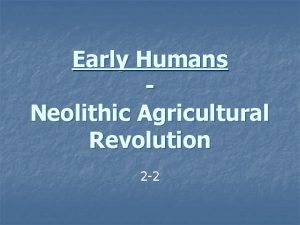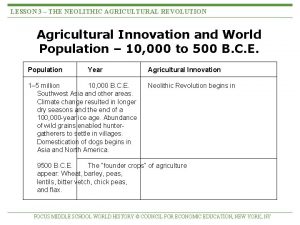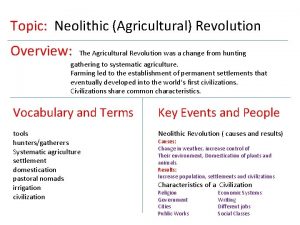Neolithic Agricultural Revolutions Neolithic Agricultural Revolutions Animal Domestications











- Slides: 11

Neolithic Agricultural Revolutions

Neolithic Agricultural Revolutions Animal Domestications America’s Middle East Asia • Llamas • Sheep • Water Buffalo • Goats • Buffalo • Pigs Africa • Wild Cattle

Neolithic Agricultural Revolutions Animal Domestications Tendencies: 1. Agriculturalist’s tended to domesticate animals that flocked toward “farms”; these animals replaced the need to hunt – domesticated animals provided milk, meat, energy, and hides.

Neolithic Agricultural Revolutions Animal Domestications Tendencies: 2. If there were no practical animals to domesticate (America’s), hunting and foraging remained a vital part of survival.

Neolithic Agricultural Revolutions Animal Domestications Tendencies: 3. If there was a shortage of food for livestock (Desert geographies) people tended to practice pastoralism, and migrated to feed their animals.

Neolithic Agricultural Revolutions Social Changes 1. People live in small towns and villages 2. Less movement and migration 3. Formation of common cultural beliefs 4. Less “free time” 5. Craft specializations 6. More interdependency 7. Spread of disease

Neolithic Agricultural Revolutions Demographic Changes 1. Population increases dramatically – food surpluses stabilize communities 2. 7500% increase during the core of the Neolithic time period! Date Population 10, 000 BCE 1, 000 5, 000 BCE 10, 000 2, 000 BCE 27, 000 1, 000 BCE 75, 000 0 CE 200, 00 0

Neolithic Agricultural Revolutions Impacts on Gender Relationships • • • POSITIVES FOR WOMEN Knowledge on what grows best required (foundations in gathering) Communities organized around kinship and marriage (matrilineal) Symbols of fertility – rise of female deities

Neolithic Agricultural Revolutions Impacts on Gender Relationships NEGATIVES FOR WOMEN • Farming becomes role of males – physically demanding • Become charged with domestic activities • Have children more frequently; don’t have to carry children on migrations anymore… • Less opportunities to gain skills outside of the domestic sphere

Neolithic Agricultural Revolutions Ancient Cities – Catal Huyuk (Anatolia)

Neolithic Agricultural Revolutions Ancient Cities – Jericho (Syria)
 First agricultural revolution ap human geography
First agricultural revolution ap human geography Similarities between animal rights and animal welfare
Similarities between animal rights and animal welfare Venn diagram animal and plant cells
Venn diagram animal and plant cells Animal rights and animal welfare venn diagram
Animal rights and animal welfare venn diagram Chapter 14 section 1 revolutions in russia answer key
Chapter 14 section 1 revolutions in russia answer key Aryan food
Aryan food Ap photo
Ap photo A tale of two revolutions grade 10, 1080l
A tale of two revolutions grade 10, 1080l Atlantic revolutions in a global context
Atlantic revolutions in a global context Nationalist revolutions sweep the west
Nationalist revolutions sweep the west Chapter 8 the enlightenment and revolutions
Chapter 8 the enlightenment and revolutions 22 revolutions
22 revolutions





















